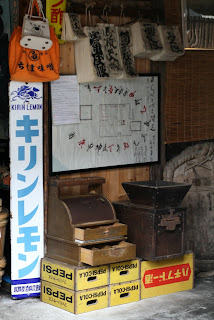Shimoda, Vol. 2.1

A 180-degree view of the bay. Click to see it bigger. I mean, really big.
Tuesday's uncooperative weather unfortunately kept me from the beach I had traveled several hours to bask on, so in the oppressive mugginess and under the impending rain from the clouds I decided to make the most of the day and have a little walkabout. I tried to hit as many of the museums as I could, and of course other landmarks around town.
Tuesday's uncooperative weather unfortunately kept me from the beach I had traveled several hours to bask on, so in the oppressive mugginess and under the impending rain from the clouds I decided to make the most of the day and have a little walkabout. I tried to hit as many of the museums as I could, and of course other landmarks around town.
 An ajisai-speckled vending machine.
An ajisai-speckled vending machine. Ajisai, or hydrangeas, are very important to Shimoda, and there is even an Ajisai Festival held every June. As ajisai season is pretty much over, I only saw a few flowers on their way out.
 An early Showa schoolowl.
An early Showa schoolowl. They tend to have very delicate souls.
They tend to have very delicate souls.How exciting to be at such a low altitude.
 Door near the owl.
Door near the owl. Shimoda in Taisho 5 (1916)
Shimoda in Taisho 5 (1916)The orange marker shows Tsuchito. Other landmarks are denoted by white labels.
My first random stop was at Tsuchito (go figure, they have a website), a 120 year-old liquor shop. Half of the shop has become a display area for original items such as signs, inventory and sales logs, a register, a pump, old photographs and postcards from the area, personal items, etc. The other half of the establishment, across the street, is still in business, and still retains the original shelving, among other things. The woman running the store with her husband and father(-in-law?) gave me a personal "tour" of the display items, explaining their use and significance. You can see her picture on the website.

The lady let me touch and hold one of the "books," written on Japanese paper. After 100 years, the pages were in perfect condition, still white, untorn, the writing unfaded and the paper unyellowed by so many seasons of exposure to the humid air.
She also let me "play" with the wooden register - that is, push the button to make the drawers open. Just like the plastic Fisher-Price one we used to play with, except ours had numbers instead of an abacus. The box with the square "funnel" is an old cash box. At the base of the funnel are wooden bars, making it easy to deposit money, but hard to get out. Unless you have the key to the lock.
 Example of namako kabe, the traditional exterior applied to many buildings in Shimoda and other Japanese cities.
Example of namako kabe, the traditional exterior applied to many buildings in Shimoda and other Japanese cities.  Old and New
Old and New An informal display of antique tools and odds-and-ends in this genkan contrasts with the tv being watched inside.
 Cemetery next to Hongakuji (?)
Cemetery next to Hongakuji (?)Each bucket is labeled with the family's name. They are used to clean the tombs.
Shimoda is riddled with small temples. I didn't even take a picture of the information board for this one, so by process of elimination I think it's Hongakuji, a small, red and white temple about which I know nothing.
Next to Hofukuji Temple (which I didn't go into) is a museum documenting the tragic life of Saito Okichi, who was essentially forced to serve Townsend Harris, the first American Consul General to Japan, in spite of her love for another man. Because she served a foreigner, she was criticized by the people, particularly the nationalists, and openly scorned, thus causing her even more grief. Because of her anguish, she began drinking and eventually drowned herself in the Inaozawa River. Each year, her death is commemorated along the banks of that river.
Apparently there's even a book about her and a couple movies.
Apparently there's even a book about her and a couple movies.


 Snuck
SnuckAs in snack-snuck-snuck
And this wasn't the only place I saw it spelled like that... in Shimoda.
 "Perry Road"
"Perry Road"Now a quaint willow-lined street accompanied by a canal, at the time of Commodore Perry's arrival in Shimoda it was purportedly a red-light district as well as an area of commerce due to its proximity to the harbor and easy access by canal.

According to the diarama at the Shimoda History Museum, most of the buildings were indeed in place by the time Perry got there.

Coming soon: Shimoda, Vol. 2.2!













0 Comments:
Post a Comment
<< Home